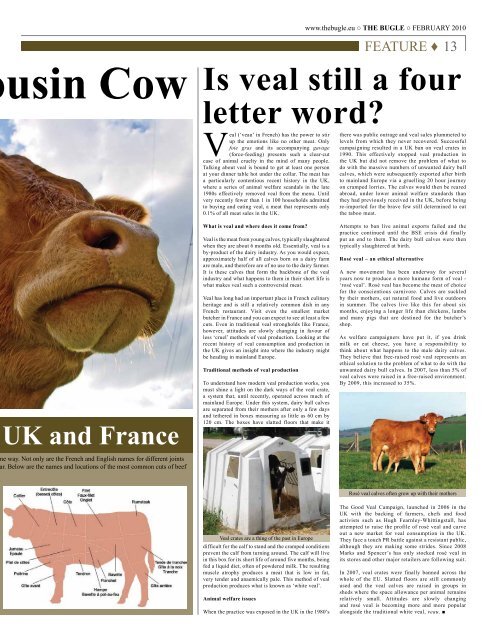Creuse is still the safest place to live in France - The Bugle
Creuse is still the safest place to live in France - The Bugle
Creuse is still the safest place to live in France - The Bugle
Create successful ePaper yourself
Turn your PDF publications into a flip-book with our unique Google optimized e-Paper software.
www.<strong>the</strong>bugle.eu ○ THE BUGLE ○ FEBRUARY 2010<br />
FEATURE ♦<br />
13<br />
us<strong>in</strong> Cow<br />
Is veal <strong>still</strong> a four<br />
letter word<br />
UK and <strong>France</strong><br />
Veal (‘veau’ <strong>in</strong> French) has <strong>the</strong> power <strong>to</strong> stir<br />
up <strong>the</strong> emotions like no o<strong>the</strong>r meat. Only<br />
foie gras and its accompany<strong>in</strong>g gavage<br />
(force-feed<strong>in</strong>g) presents such a clear-cut<br />
case of animal cruelty <strong>in</strong> <strong>the</strong> m<strong>in</strong>d of many people.<br />
Talk<strong>in</strong>g about veal <strong>is</strong> bound <strong>to</strong> get at least one person<br />
at your d<strong>in</strong>ner table hot under <strong>the</strong> collar. <strong>The</strong> meat has<br />
a particularly contentious recent h<strong>is</strong><strong>to</strong>ry <strong>in</strong> <strong>the</strong> UK,<br />
where a series of animal welfare scandals <strong>in</strong> <strong>the</strong> late<br />
1980s effectively removed veal from <strong>the</strong> menu. Until<br />
very recently fewer than 1 <strong>in</strong> 100 households admitted<br />
<strong>to</strong> buy<strong>in</strong>g and eat<strong>in</strong>g veal, a meat that represents only<br />
0.1% of all meat sales <strong>in</strong> <strong>the</strong> UK.<br />
What <strong>is</strong> veal and where does it come from<br />
Veal <strong>is</strong> <strong>the</strong> meat from young calves, typically slaughtered<br />
when <strong>the</strong>y are about 6 months old. Essentially, veal <strong>is</strong> a<br />
by-product of <strong>the</strong> dairy <strong>in</strong>dustry. As you would expect,<br />
approximately half of all calves born on a dairy farm<br />
are male, and <strong>the</strong>refore are of no use <strong>to</strong> <strong>the</strong> dairy farmer.<br />
It <strong>is</strong> <strong>the</strong>se calves that form <strong>the</strong> backbone of <strong>the</strong> veal<br />
<strong>in</strong>dustry and what happens <strong>to</strong> <strong>the</strong>m <strong>in</strong> <strong>the</strong>ir short life <strong>is</strong><br />
what makes veal such a controversial meat.<br />
Veal has long had an important <strong>place</strong> <strong>in</strong> French cul<strong>in</strong>ary<br />
heritage and <strong>is</strong> <strong>still</strong> a relatively common d<strong>is</strong>h <strong>in</strong> any<br />
French restaurant. V<strong>is</strong>it even <strong>the</strong> smallest market<br />
butcher <strong>in</strong> <strong>France</strong> and you can expect <strong>to</strong> see at least a few<br />
cuts. Even <strong>in</strong> traditional veal strongholds like <strong>France</strong>,<br />
however, attitudes are slowly chang<strong>in</strong>g <strong>in</strong> favour of<br />
less ‘cruel’ methods of veal production. Look<strong>in</strong>g at <strong>the</strong><br />
recent h<strong>is</strong><strong>to</strong>ry of veal consumption and production <strong>in</strong><br />
<strong>the</strong> UK gives an <strong>in</strong>sight <strong>in</strong><strong>to</strong> where <strong>the</strong> <strong>in</strong>dustry might<br />
be head<strong>in</strong>g <strong>in</strong> ma<strong>in</strong>land Europe.<br />
Traditional methods of veal production<br />
To understand how modern veal production works, you<br />
must sh<strong>in</strong>e a light on <strong>the</strong> dark ways of <strong>the</strong> veal crate,<br />
a system that, until recently, operated across much of<br />
ma<strong>in</strong>land Europe. Under th<strong>is</strong> system, dairy bull calves<br />
are separated from <strong>the</strong>ir mo<strong>the</strong>rs after only a few days<br />
and te<strong>the</strong>red <strong>in</strong> boxes measur<strong>in</strong>g as little as 60 cm by<br />
120 cm. <strong>The</strong> boxes have slatted floors that make it<br />
<strong>the</strong>re was public outrage and veal sales plummeted <strong>to</strong><br />
levels from which <strong>the</strong>y never recovered. Successful<br />
campaign<strong>in</strong>g resulted <strong>in</strong> a UK ban on veal crates <strong>in</strong><br />
1990. Th<strong>is</strong> effectively s<strong>to</strong>pped veal production <strong>in</strong><br />
<strong>the</strong> UK but did not remove <strong>the</strong> problem of what <strong>to</strong><br />
do with <strong>the</strong> massive numbers of unwanted dairy bull<br />
calves, which were subsequently exported after birth<br />
<strong>to</strong> ma<strong>in</strong>land Europe via a gruell<strong>in</strong>g 20 hour journey<br />
on cramped lorries. <strong>The</strong> calves would <strong>the</strong>n be reared<br />
abroad, under lower animal welfare standards than<br />
<strong>the</strong>y had previously received <strong>in</strong> <strong>the</strong> UK, before be<strong>in</strong>g<br />
re-imported for <strong>the</strong> brave few <strong>still</strong> determ<strong>in</strong>ed <strong>to</strong> eat<br />
<strong>the</strong> taboo meat.<br />
Attempts <strong>to</strong> ban <strong>live</strong> animal exports failed and <strong>the</strong><br />
practice cont<strong>in</strong>ued until <strong>the</strong> BSE cr<strong>is</strong><strong>is</strong> did f<strong>in</strong>ally<br />
put an end <strong>to</strong> <strong>the</strong>m. <strong>The</strong> dairy bull calves were <strong>the</strong>n<br />
typically slaughtered at birth.<br />
Rosé veal – an ethical alternative<br />
A new movement has been underway for several<br />
years now <strong>to</strong> produce a more humane form of veal -<br />
‘rosé veal’. Rosé veal has become <strong>the</strong> meat of choice<br />
for <strong>the</strong> conscientious carnivore. Calves are suckled<br />
by <strong>the</strong>ir mo<strong>the</strong>rs, eat natural food and <strong>live</strong> outdoors<br />
<strong>in</strong> summer. <strong>The</strong> calves <strong>live</strong> like th<strong>is</strong> for about six<br />
months, enjoy<strong>in</strong>g a longer life than chickens, lambs<br />
and many pigs that are dest<strong>in</strong>ed for <strong>the</strong> butcher’s<br />
shop.<br />
As welfare campaigners have put it, if you dr<strong>in</strong>k<br />
milk or eat cheese, you have a responsibility <strong>to</strong><br />
th<strong>in</strong>k about what happens <strong>to</strong> <strong>the</strong> male dairy calves.<br />
<strong>The</strong>y believe that free-ra<strong>is</strong>ed rosé veal represents an<br />
ethical solution <strong>to</strong> <strong>the</strong> problem of what <strong>to</strong> do with <strong>the</strong><br />
unwanted dairy bull calves. In 2007, less than 5% of<br />
veal calves were ra<strong>is</strong>ed <strong>in</strong> a free-ra<strong>is</strong>ed environment.<br />
By 2009, th<strong>is</strong> <strong>in</strong>creased <strong>to</strong> 35%.<br />
e way. Not only are <strong>the</strong> French and Engl<strong>is</strong>h names for different jo<strong>in</strong>ts<br />
r. Below are <strong>the</strong> names and locations of <strong>the</strong> most common cuts of beef<br />
Veal crates are a th<strong>in</strong>g of <strong>the</strong> past <strong>in</strong> Europe<br />
difficult for <strong>the</strong> calf <strong>to</strong> stand and <strong>the</strong> cramped conditions<br />
prevent <strong>the</strong> calf from turn<strong>in</strong>g around. <strong>The</strong> calf will <strong>live</strong><br />
<strong>in</strong> th<strong>is</strong> box for its short life of around five months, be<strong>in</strong>g<br />
fed a liquid diet, often of powdered milk. <strong>The</strong> result<strong>in</strong>g<br />
muscle atrophy produces a meat that <strong>is</strong> low <strong>in</strong> fat,<br />
very tender and anaemically pale. Th<strong>is</strong> method of veal<br />
production produces what <strong>is</strong> known as ‘white veal’.<br />
Animal welfare <strong>is</strong>sues<br />
When <strong>the</strong> practice was exposed <strong>in</strong> <strong>the</strong> UK <strong>in</strong> <strong>the</strong> 1980’s<br />
Rosé veal calves often grow up with <strong>the</strong>ir mo<strong>the</strong>rs<br />
<strong>The</strong> Good Veal Campaign, launched <strong>in</strong> 2006 <strong>in</strong> <strong>the</strong><br />
UK with <strong>the</strong> back<strong>in</strong>g of farmers, chefs and food<br />
activ<strong>is</strong>ts such as Hugh Fearnley-Whitt<strong>in</strong>gstall, has<br />
attempted <strong>to</strong> ra<strong>is</strong>e <strong>the</strong> profile of rosé veal and carve<br />
out a new market for veal consumption <strong>in</strong> <strong>the</strong> UK.<br />
<strong>The</strong>y face a <strong>to</strong>uch PR battle aga<strong>in</strong>st a res<strong>is</strong>tant public,<br />
although <strong>the</strong>y are mak<strong>in</strong>g some strides. S<strong>in</strong>ce 2008<br />
Marks and Spencer’s has only s<strong>to</strong>cked rosé veal <strong>in</strong><br />
its s<strong>to</strong>res and o<strong>the</strong>r major retailers are follow<strong>in</strong>g suit.<br />
In 2007, veal crates were f<strong>in</strong>ally banned across <strong>the</strong><br />
whole of <strong>the</strong> EU. Slatted floors are <strong>still</strong> commonly<br />
used and <strong>the</strong> veal calves are ra<strong>is</strong>ed <strong>in</strong> groups <strong>in</strong><br />
sheds where <strong>the</strong> space allowance per animal rema<strong>in</strong>s<br />
relatively small. Attitudes are slowly chang<strong>in</strong>g<br />
and rosé veal <strong>is</strong> becom<strong>in</strong>g more and more popular<br />
alongside <strong>the</strong> traditional white veal, veau. ■
















